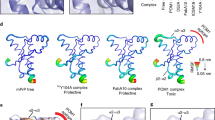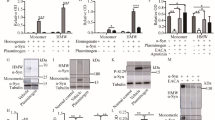Abstract
Transmissible spongiform encephalopathies are associated with accumulation of PrPSc, a conformer of a cellular protein called PrPC. PrPSc is thought to replicate by imparting its conformation onto PrPC (ref. 1), yet conformational discrimination between PrPC and PrPSc has remained elusive. Because deposition of PrPSc alone is not enough to cause neuropathology2, PrPSc probably damages the brain by interacting with other cellular constituents. Here we find activities in human and mouse blood which bind PrPSc and prion infectivity, but not PrPC. We identify plasminogen, a pro-protease implicated in neuronal excitotoxicity3,4, as a PrPSc-binding protein. Binding is abolished if the conformation of PrPSc is disrupted by 6M urea or guanidine. The isolated lysine binding site 1 of plasminogen (kringles I–III) retains this binding activity, and binding can be competed for with lysine. Therefore, plasminogen represents the first endogenous factor discriminating between normal and pathological prion protein. This unexpected property may be exploited for diagnostic purposes.
This is a preview of subscription content, access via your institution
Access options
Subscribe to this journal
Receive 51 print issues and online access
$199.00 per year
only $3.90 per issue
Buy this article
- Purchase on Springer Link
- Instant access to full article PDF
Prices may be subject to local taxes which are calculated during checkout




Similar content being viewed by others
References
Prusiner, S. B. Novel proteinaceous infectious particles cause scrapie. Science 216, 136–144 ( 1982).
Brandner, S. et al. Normal host prion protein necessary for scrapie-induced neurotoxicity. Nature 379, 339–343 (1996).
Chen, Z. L. & Strickland, S. Neuronal death in the hippocampus is promoted by plasmin-catalyzed degradation of laminin. Cell 91, 917–925 (1997).
Tsirka, S. E., Rogove, A. D. & Strickland, S. Neuronal cell death and tPA. Nature 384, 123–124 (1996).
Büeler, H. R. et al. Normal development and behaviour of mice lacking the neuronal cell-surface PrP protein. Nature 356, 577 –582 (1992).
Korth, C. et al. Prion (PrPSc)-specific epitope defined by a monoclonal antibody. Nature 390, 74– 77 (1997).
Prusiner, S. B. & Scott, M. R. Genetics of prions. Annu. Rev. Genet. 31, 139– 175 (1997).
Fischer, M. et al. Prion protein (PrP) with amino-proximal deletions restoring susceptibility of PrP knockout mice to scrapie. EMBO J. 15, 1255–1264 (1996).
Riek, R. et al. NMR structure of the mouse prion protein domain Prp(121–231). Nature 382, 180–182 (1996).
Riek, R., Hornemann, S., Wider, G., Glockshuber, R. & Wüthrich, K. NMR characterization of the full-length recombinant murine prion protein, mPrP(23–231). FEBS Lett. 413, 282–288 (1997).
Shibuya, S., Higuchi, J., Shin, R. W., Tateishi, J. & Kitamoto, T. Protective prion protein polymorphisms against sporadic Creutzfeldt- Jakob disease. Lancet 351, 419 (1998).
Zulianello, L. et al. Dominant-negative inhibition of prion formation diminished by deletion mutagenesis of the prion protein. J. Virol. 74, 4351–4360 (2000).
Telling, G. C. et al. Prion propagation in mice expressing human and chimeric PrP transgenes implicates the interaction of cellular PrP with another protein. Cell 83, 79–90 (1995).
Kaneko, K. et al. Evidence for protein X binding to a discontinuous epitope on the cellular prion protein during scrapie prion propagation. Proc. Natl Acad. Sci. USA 94, 10069– 10074 (1997).
Madani, R. et al. Enhanced hippocampal long-term potentiation and learning by increased neuronal expression of tissue-type plasminogen activator in transgenic mice. EMBO J. 18, 3007– 3012 (1999).
Baranes, D. et al. Tissue plasminogen activator contributes to the late phase of LTP and to synaptic growth in the hippocampal mossy fiber pathway. Neuron 21, 813–825 ( 1998).
Ledesma, M. D. et al. Brain plasmin influences APP alpha-cleavage and Aβ degradation and is reduced in Alzheimer's disease brains. EMBO Rep. (in the press).
Naslavsky, N., Stein, R., Yanai, A., Friedlander, G. & Taraboulos, A. Characterization of detergent-insoluble complexes containing the cellular prion protein and its scrapie isoform. J. Biol. Chem. 272, 6324–6331 ( 1997).
Houston, F., Foster, J. D., Chong, A., Hunter, N. & Bostock, C. J. Transmission of BSE by blood transfusion in sheep. Lancet 356, 999–1000 (2000).
Prusiner, S. B. et al. Measurement of the scrapie agent using an incubation time interval assay. Ann. Neurol. 11, 353– 358 (1982).
Acknowledgements
We are grateful to D. Voelkel for providing fractionated human plasma, to P. Sonderegger, C. Weissmann, T. Lührs, and W. Schaffner for critical advice, and to M. Maissen and R. Hardegger for experimental help. This study was supported by grants from the European Union (Bundesamt für Bildung und Wissenschaft), the Swiss National Research Programs to A.A. and by a grant-in-aid of the SigmaXi foundation to M.B.F.
Author information
Authors and Affiliations
Corresponding author
Rights and permissions
About this article
Cite this article
Fischer, M., Roeckl, C., Parizek, P. et al. Binding of disease-associated prion protein to plasminogen. Nature 408, 479–483 (2000). https://doi.org/10.1038/35044100
Received:
Accepted:
Issue Date:
DOI: https://doi.org/10.1038/35044100
This article is cited by
-
The Effect of Plasminogen-Derived Peptides to PrPSc Formation
International Journal of Peptide Research and Therapeutics (2022)
-
Metal Ions Bound to Prion Protein Affect its Interaction with Plasminogen Activation System
The Protein Journal (2022)
-
Ablation of matrix metalloproteinase-9 gene decreases cerebrovascular permeability and fibrinogen deposition post traumatic brain injury in mice
Metabolic Brain Disease (2015)
-
Biological network inferences for a protection mechanism against familial Creutzfeldt-Jakob disease with E200K pathogenic mutation
BMC Medical Genomics (2014)
-
Global Protein Differential Expression Profiling of Cerebrospinal Fluid Samples Pooled from Chinese Sporadic CJD and non-CJD Patients
Molecular Neurobiology (2014)
Comments
By submitting a comment you agree to abide by our Terms and Community Guidelines. If you find something abusive or that does not comply with our terms or guidelines please flag it as inappropriate.



